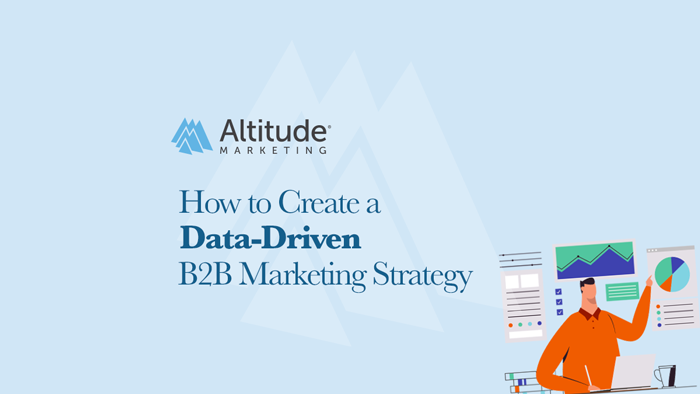Every B2B marketer wants to be known as data-driven. But it’s one of those things that’s much easier said than done. So how do you create a data-driven B2B marketing strategy?
We’ll start by telling you that typically, the way you think it’s done isn’t how it’s actually done.
Here’s why: In B2B, our datasets are vanishingly small.
A lot of rather successful B2B websites get 100 or 200 visitors a day. A lot of extremely high-performing B2B email campaigns will get 12-15% open rates. And a lot of good B2B social media presences have followers in the hundreds.
And we’re talking about reputable companies here. Making not 6, not 7, but rather 8 figures.
So what does this all mean? In B2B, we need to look at data a different way. Not as an affirmation of what we’ve done – but rather as an indication.
A data-driven B2B marketing strategy is like sending up smoke signals. It’s not something we can look at it and say yes this works or no this doesn’t work. It’s all part of a much bigger whole. It doesn’t tell us anything concrete because the sets are so small. But it is giving us little pieces of what we could do.
So with that being said, here are two key points to consider when creating a data-driven B2B marketing strategy.

Strategy Tip #1: Don’t Obsess Over Data
To be a data-driven B2B company or agency, your first task is to not obsess over data. If you’re going to write a blog post and see how many people read it, it’s not really the best use of your time. Why? Because if you’re a B2B company, you’re probably writing really niche, weird stuff.
But weird is normal in B2B.
A lot of your blog posts will be read by, like, seven people. Maybe 10 people if you’re Mark Twaining it up. But that’s OK. Remember, you don’t need the masses. You need the specific people that align with your target audience.
If your KPI is traffic – statistically significant traffic – you might be appealing to the wrong crowd.
Remember, the more you obsess over things and try to set super-specific metrics, the more likely you are to think about the wrong things. Data isn’t the goal. Driving new business is.
Strategy Tip #2: Data Literacy Is a Must
To have a data-driven B2B marketing strategy, it’s not about staring at numbers. It’s about data literacy. Understanding what you’re looking at – not obsessing. You need to be able to contextualize what you’re looking at.
In B2B, our numbers are going to be small. They should be small. We’re only selling to so many people. If you’re a B2B company selling the world’s greatest HR software, you might have a potential customer pool of around 50,000 folks. And if you shave that down to the biggest companies out there, that number plummets to 1,000 customers. On the other hand, if you’re a company selling sunglasses, your pool of customers is hundreds of millions of people. Quite a difference there.
What does this actually mean? What is this telling me going forward? That’s what you need to think about when you’re staring at numbers.
That’s what data literacy is all about.
Bottom Line: Creating a Data-Driven B2B Marketing Strategy
Being a B2B data-driven company isn’t just about having numbers in front of you. Sure, numbers are important. To an extent. You need goals and stuff. But if your goal is to have 500 people read your blog post by tomorrow, you’re doing data-driven marketing wrong.
What you’re doing should be part of the greater whole. Look at the bigger picture. Use the numbers to ask yourself: Is this really contributing?
If you do this and understand the context of the data you’re looking at, you’re going to do well.
If you spend your time in spreadsheets instead, you’re inevitably going to be disappointed.
But you shouldn’t be.



